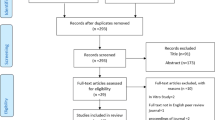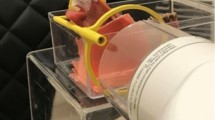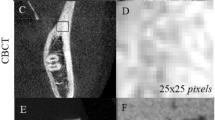Abstract
Objectives
This study aims to evaluate the effects of histogram equalization (HE) and contrast limited adaptive histogram equalization (CLAHE) on periapical images and fractal dimensions in the periapical region.
Methods
In this cross-sectional study, digital periapical images were selected from the archive of Dentistry School of Isfahan University of Medical Sciences. The radiographs were taken from mandibular and maxillary anterior single root teeth with healthy root and periodontium. After applying HE and CLAHE algorithms to images, two radiologists evaluated the quality of apex detection from using a 5-point Likert scale (from 5 for very good image quality to 1 for very bad image quality). Afterward, all the images were imported to the ImageJ application, and the region of interest (ROI) was specified as the region between the two central incisors. The fractal box-counting method was used to determine fractal dimensions (FD) values. Nonparametric Wilcoxon–Friedman test, Intraclass Correlation Coefficient test, T-test, and Pair T-test were performed as statistical analysis (α = 0.05).
Results
Fifty-three radiographs were analyzed and the image quality assessments were significantly different between raw images and images after performing HE, CLAHE (p value < 0.001), and using CLAHE algorithm significantly increases image quality assessments more than HE (p value = 0.009). There was a significant difference in FD values for images after applying CLAHE and HE compared to raw images (p value < 0.001), and HE decreased the FD value significantly more than CLAHE (p value = 0.019).
Conclusions
Employing CLAHE and HE algorithm via OpenCV python library improves the periapical image quality, which is more significant using the CLAHE algorithm. Moreover, applying CLAHE and HE reduces trabecular bone structure detection and FD values in periapical images, especially in HE.



Similar content being viewed by others
References
Karuntanović T, et al. In vitro comparison of the accuracy of two apex locators of different generations. Acta Medica Medianae. 2019;58(1):28–32.
Arslan ZB, et al. Diagnostic accuracy of panoramic radiography and ultrasonography in detecting periapical lesions using periapical radiography as a gold standard. Dentomaxillofac Radiol. 2020;49(6):20190290.
Katayama R. Series: practical evaluation of clinical image quality (1): image quality verification of digital radiography. Igaku Butsuri. 2016;35(4):307–13.
Çalışkan A, Sumer AP. Definition, classification and retrospective analysis of photostimulable phosphor image artefacts and errors in intraoral dental radiography. Dentomaxillofac Radiol. 2017;46(3):20160188.
Raghav N, et al. Comparison of the efficacy of conventional radiography, digital radiography, and ultrasound in diagnosing periapical lesions. Oral Surg Oral Med Oral Pathol Oral Radiol Endod. 2010;110(3):379–85.
Shah N, Bansal N, Logani A. Recent advances in imaging technologies in dentistry. World J Radiol. 2014;6(10):794–807.
Lo WY, Puchalski SM. Digital image processing. Vet Radiol Ultrasound. 2008;49(1 Suppl 1):S42–7.
Alkhaled F, Hasan A, Alhammad A. Improving radiographic image contrast using multi layers of histogram equalization technique. IAES Int J Artif Intell. 2021;10:151–6.
White SC, Pharoah MJ. Oral radiology: principles and interpretation. St. Louis: Mosby Inc.; 2019.
Subramani B, Veluchamy M. Fuzzy gray level difference histogram equalization for medical image enhancement. J Med Syst. 2020;44(6):103.
Kumar A, Bhadauria HS, Singh A. Descriptive analysis of dental X-ray images using various practical methods: a review. PeerJ Comput Sci. 2021;7: e620.
Zimmerman JB, et al. A psychophysical comparison of two methods for adaptive histogram equalization. J Digit Imaging. 1989;2(2):82–91.
Leszczynski KW, Shalev S, Cosby NS. The enhancement of radiotherapy verification images by an automated edge detection technique. Med Phys. 1992;19(3):611–21.
Pretty IA. Caries detection and diagnosis: novel technologies. J Dent. 2006;34(10):727–39.
Pizer SM, et al. Adaptive histogram equalization and its variations. Comput Vis Graph Image Process. 1987;39(3):355–68.
Singh P, Mukundan R, De Ryke R. Feature enhancement in medical ultrasound videos using contrast-limited adaptive histogram equalization. J Digit Imaging. 2020;33(1):273–85.
Niroomandfam B, NickravanShalmani A, Khalilian M. Breast abnormalities segmentation using the wavelet transform coefficients aggregation. Iran Quart J Breast Dis. 2019;12(2):57–71.
Kalyani J, Chakraborty M. Contrast enhancement of MRI images using histogram equalization techniques. in 2020 International Conference on Computer, Electrical & Communication Engineering (ICCECE); 2020.
Albeiruti H, AwheedJeiad H. OPG images preprocessing enhancement for diagnosis purposes. Int J Sci Res. 2018;7:1656–64.
Leonardi Dutra K, et al. Diagnostic accuracy of cone-beam computed tomography and conventional radiography on apical periodontitis: a systematic review and meta-analysis. J Endod. 2016;42(3):356–64.
Palatyńska-Ulatowska A, et al. The pulp stones: morphological analysis in scanning electron microscopy and spectroscopic chemical quantification. Medicina (Kaunas). 2021;58(1):5.
Alwazzan MJ, Ismael MA, Ahmed AN. A hybrid algorithm to enhance colour retinal fundus images using a wiener filter and CLAHE. J Digit Imaging. 2021;34(3):750–9.
Qassim HM, Basheer NM, Farhan MN. Brightness preserving enhancement for dental digital X-ray images based on entropy and histogram analysis. J Appl Sci Eng. 2019;22(1):187–94.
ElSayed A, Yousef WA, Matlab vs. OpenCV: a comparative study of different machine learning algorithms. ArXiv, 2019. abs/1905.01213.
Soltani P, et al. Application of fractal analysis in detecting trabecular bone changes in periapical radiograph of patients with periodontitis. Int J Dent. 2021;2021:3221448.
Coşgunarslan A, et al. The evaluation of the mandibular bone structure changes related to lactation with fractal analysis. Oral Radiol. 2020;36(3):238–47.
Meier AW, et al. Interpretation of chemically created periapical lesions using direct digital imaging. J Endod. 1996;22(10):516–20.
Rahmi-Fajrin H, et al. Dental radiography image enhancement for treatment evaluation through digital image processing. J Clin Exp Dent. 2018;10(7):e629–34.
Mehdizadeh M, Dolatyar S. Study of effect of adaptive histogram equalization on image quality in digital preapical image in pre apex area. Res J Biol Sci. 2009;4(8):922–4.
Acknowledgements
The present study was funded by Isfahan University of Medical Sciences (3400670) and was performed as a partial requirement for obtaining DDS degree.
Funding
The present study was funded by Isfahan University of Medical Sciences (3400670) and was performed as a partial requirement for obtaining DDS degree.
Author information
Authors and Affiliations
Corresponding author
Ethics declarations
Conflict of interest
All authors declare that they have no conflicts of interest.
Ethics approval
All procedures followed were in accordance with the ethical standards of the responsible committee on human experimentation (institutional and national) and with the Helsinki Declaration of 1975, as revised in 2008. All procedures performed in the present study was approved by the Ethical Committee of Isfahan University of Medical Sciences (#IR.MUI.RESEARCH.REC.1400.412).
Additional information
Publisher's Note
Springer Nature remains neutral with regard to jurisdictional claims in published maps and institutional affiliations.
Rights and permissions
Springer Nature or its licensor holds exclusive rights to this article under a publishing agreement with the author(s) or other rightsholder(s); author self-archiving of the accepted manuscript version of this article is solely governed by the terms of such publishing agreement and applicable law.
About this article
Cite this article
Mehdizadeh, M., Tavakoli Tafti, K. & Soltani, P. Evaluation of histogram equalization and contrast limited adaptive histogram equalization effect on image quality and fractal dimensions of digital periapical radiographs. Oral Radiol 39, 418–424 (2023). https://doi.org/10.1007/s11282-022-00654-7
Received:
Accepted:
Published:
Issue Date:
DOI: https://doi.org/10.1007/s11282-022-00654-7




